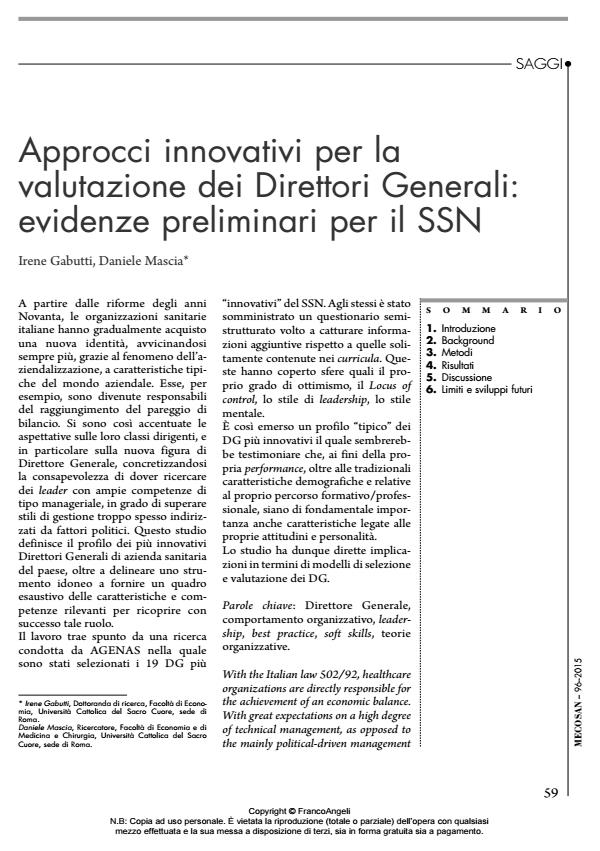Approcci innovativi per la valutazione dei Direttori Generali: evidenze preliminari per il SSN
Titolo Rivista MECOSAN
Autori/Curatori Irene Gabutti, Daniele Mascia
Anno di pubblicazione 2016 Fascicolo 2015/96
Lingua Italiano Numero pagine 21 P. 59-79 Dimensione file 355 KB
DOI 10.3280/MESA2015-096004
Il DOI è il codice a barre della proprietà intellettuale: per saperne di più
clicca qui
Qui sotto puoi vedere in anteprima la prima pagina di questo articolo.
Se questo articolo ti interessa, lo puoi acquistare (e scaricare in formato pdf) seguendo le facili indicazioni per acquistare il download credit. Acquista Download Credits per scaricare questo Articolo in formato PDF

FrancoAngeli è membro della Publishers International Linking Association, Inc (PILA)associazione indipendente e non profit per facilitare (attraverso i servizi tecnologici implementati da CrossRef.org) l’accesso degli studiosi ai contenuti digitali nelle pubblicazioni professionali e scientifiche
A partire dalle riforme degli anni Novanta, le organizzazioni sanitarie italiane hanno gradualmente acquisto una nuova identità, avvicinandosi sempre più, grazie al fenomeno dell’aziendalizzazione, a caratteristiche tipiche del mondo aziendale. Esse, per esempio, sono divenute responsabili del raggiungimento del pareggio di bilancio. Si sono così accentuate le aspettative sulle loro classi dirigenti, e in particolare sulla nuova figura di Direttore Generale, concretizzandosi la consapevolezza di dover ricercare dei leader con ampie competenze di tipo manageriale, in grado di superare stili di gestione troppo spesso indirizzati da fattori politici. Questo studio definisce il profilo dei più innovativi Direttori Generali di azienda sanitaria del paese, oltre a delineare uno strumento idoneo a fornire un quadro esaustivo delle caratteristiche e competenze rilevanti per ricoprire con successo tale ruolo. Il lavoro trae spunto da una ricerca condotta da AGENAS nella quale sono stati selezionati i 19 DG più "innovativi" del SSN. Agli stessi è stato somministrato un questionario semistrutturato volto a catturare informazioni aggiuntive rispetto a quelle solitamente contenute nei curricula. Queste hanno coperto sfere quali il proprio grado di ottimismo, il Locus of control, lo stile di leadership, lo stile mentale. È così emerso un profilo "tipico" dei DG più innovativi il quale sembrerebbe testimoniare che, ai fini della propria performance, oltre alle tradizionali caratteristiche demografiche e relative al proprio percorso formativo/professionale, siano di fondamentale importanza anche caratteristiche legate alle proprie attitudini e personalità. Lo studio ha dunque dirette implicazioni in termini di modelli di selezione e valutazione dei DG.
Parole chiave:Direttore Generale, comportamento organizzativo, leadership, best practice, soft skills, teorie organizzative.
Irene Gabutti, Daniele Mascia, Approcci innovativi per la valutazione dei Direttori Generali: evidenze preliminari per il SSN in "MECOSAN" 96/2015, pp 59-79, DOI: 10.3280/MESA2015-096004